Introduction :
If you want to know more about the HANA / Full Use / Run Time / Enterprise Edition license options, you are on the right page. Let's start by taking a step back.
The architecture work consists of studying the needs and uses of our clients in order to propose a tool layout that is the most relevant in terms of agility, functionality, cost and scalability.
This work is often complicated by licence limitations and Software Usage Right (SUR) terms. It is therefore necessary to guarantee the compliance of the proposed architectures to avoid problems during audits by software publishers.
This blog can give you some hints to understand the issues and see what is feasible or not depending on your BI strategy. This post has no legal value and cannot be used against SAP or Bilink. We recommend that you systematically validate your architecture diagrams with SAP or your approved integrator before implementing them so as not to put yourself in violation.
In the case of SAP, and more specifically with HANA technologies, everything becomes more complicated. This comes from the dual use of HANA technology:
- Powering applications such as BW, BO, BFC, ECC, S/4 or others. In this case, the HANA database replaces another database such as Oracle or SQL.
- Develop applications directly on the HANA database using the database engines.
Conceptually, in the first case it is the application that interacts with the HANA database, while in the second case the developer models directly in the database. HANA technology allows both options and executes them with excellent results.
1. What are the HANA licensing options offered by SAP?
SAP offers two categories of licenses: Run Time (RT) or Full Use:
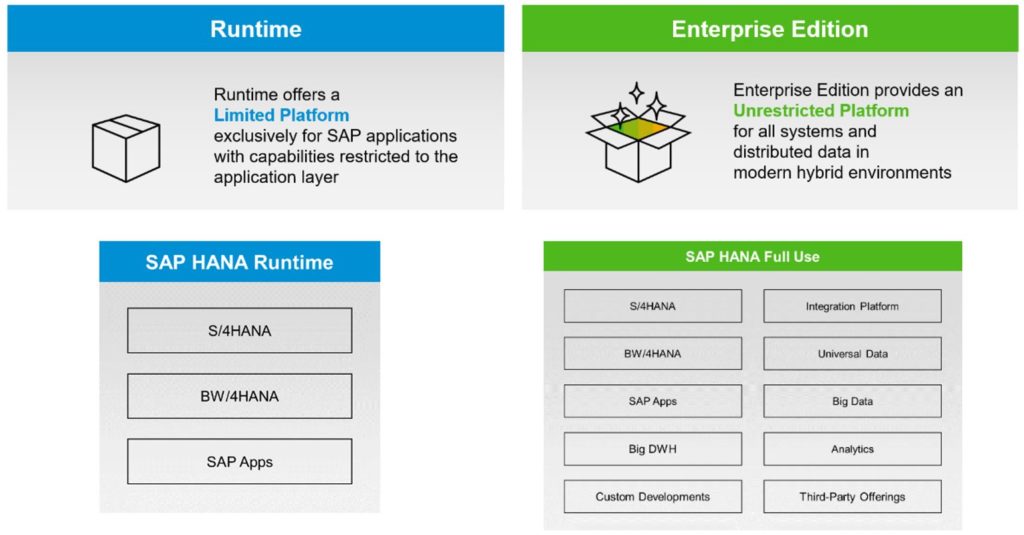
1.1 The HANA Run Time Licence
In general, Run Time is used in the following cases:
- Only for SAP applications (S/4, BW/4, BW, BO etc.)
- Modelling, administration, creation of data structures and the use of advanced engines should only be done via the application layer
- SAP and non-SAP data can only be loaded, exported and managed via the application layer and with SAP data provisioning technologies.
- Loading data in data structures generated by the SAP application directly into SAP HANA is allowed with DI, SDI and SLT only.
- Direct access to SAP HANA views through certified analytical tools
Run Time allows the applications supported by the HANA database to be motorised. This License mode is itself broken down into two types:
- RT8% also called REB, Run Time Edition for BW
In this case, the only application that can be motorised is BW and not BW/4
- RT15% or REAB, Run Time Edition for Applications and BW
The applications that can be motorised are precisely defined by SAP, but include ECC, BFC, BPC, BW and most SAP products.
The illustration below gives more details on the differences between the REAB and REB Run Time:
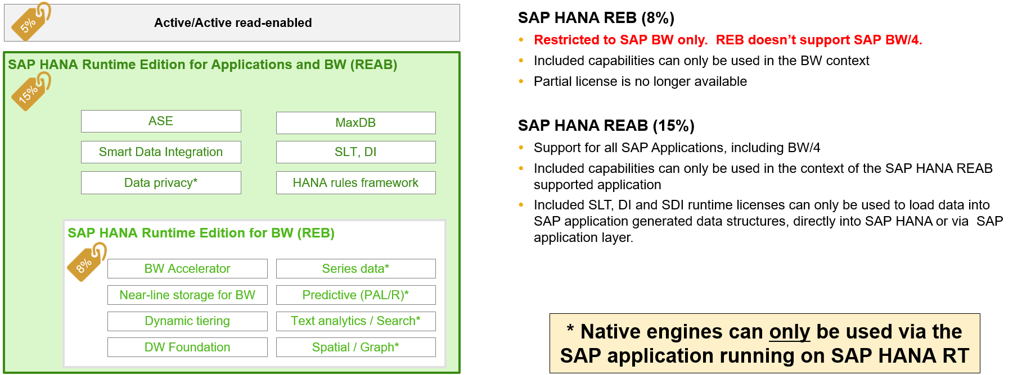
This diagram is not contractual, as it seems to me that under certain conditions, SLT from SAP data is possible in Run Time (REB)
In addition, some data visualization applications are certified to access the HANA database directly even via the Run Time License mode. The applications are listed in the link below:
https://www.sap.com/dmc/exp/2013_09_adpd/enEN/#/d/solutions?filters=326;405;352
1.2 The HANA license Full use
In general, Full Use is used in the following cases:
- For any combination of SAP, non-SAP, custom, third-party and hybrid applications
- No limitations on data modelling, administration, creation of custom structures and use of advanced engines directly through SAP HANA studio or other applications
- No limitations on loading and exporting SAP and non-SAP data directly into and out of SAP HANA
- No limitation on data consumption directly from SAP HANA
Full Use allows you to develop directly on the HANA base and is presented in two offers:
- The Full Use Standard Edition
- The Full Use Enterprise Edition
The image below gives some examples of the main differences between the Enterprise Edition and the Full Use Edition.
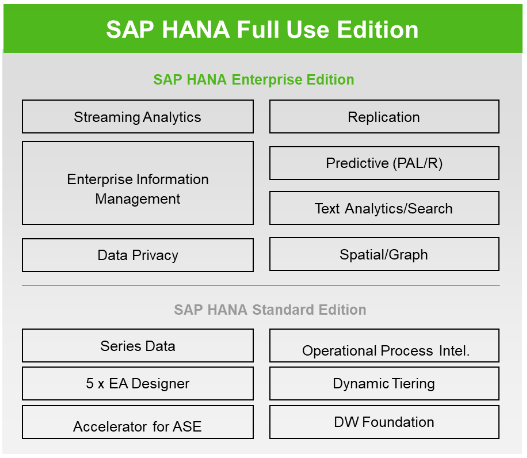
1.3 Full Use vs. Run Time licences
The differences between Run Time and Full Use are explained in the table below. The Full Use version described below is the Enterprise Edition and not the Standard Edition. This table is a good summary of the SUR (Software Use Rights) although it does not replace it:
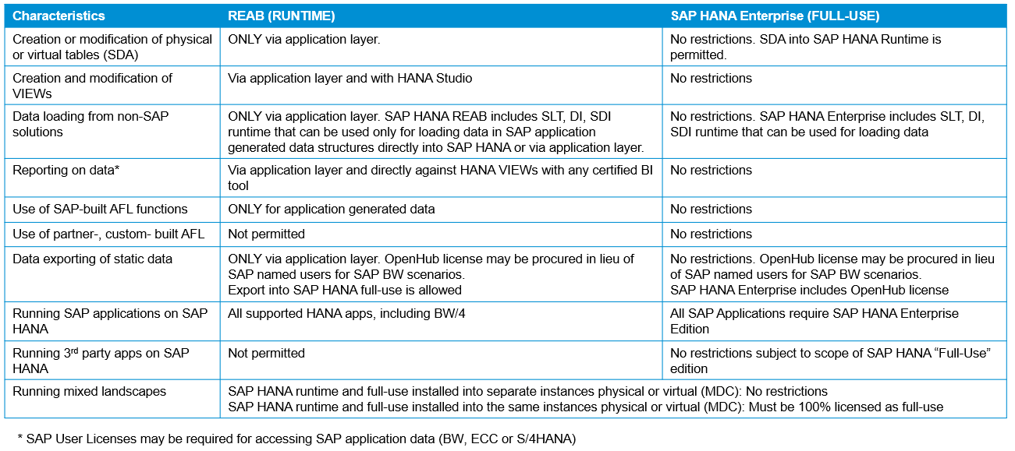
2. What is the functionality of each model? Use cases
To put it simply, you can do almost anything in Full Use Enterprise Edition, there are functional restrictions in Full Use Standard Edition and finally the restrictions are strongest in Run Time 15% and 8%.
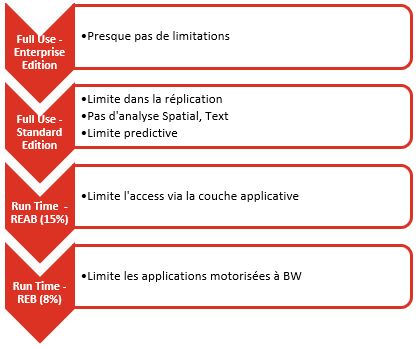
We will detail the cost and ROI aspects later, as these constraints also go hand in hand with a different pricing model, which is, in most cases, decreasing in parallel with the reduction in functionality.
In general, if you want to use your HANA database as an integration platform within the application landscape, storing and propagating your data with non-SAP systems or technical users, while using the native functionality of the database without going through the application layer, you are in a Full Use scenario.
Below are some Full Use cases:
- Write directly to the HANA database without going through the application layer
- Create tables in HANA without using SDI/SDA/SLT or an application like BW
- Connect your non-SAP reporting tools to the HANA database (Tableau, Qlik etc.)
- Modeling basic applications and accessing them via visualization tools such as Fiori
- Using SLT with Non-SAP data sources
There is one aspect that is not very clear both in the documentation and in SAP's communications: it is the technical possibility of powering an SAP BW application via a Full Use Standard Edition Licence. It seems to me that this is possible according to the document: " SAP List of Prices and Conditions SAP Software and Support 2019/4 ".
However, if your goal is to accelerate an existing application such as BW with the in-memory performance and columnar storage that HANA offers, then Run Time Licensing is the most appropriate and often the most cost-effective approach.
Below are some Run Time use cases:
- Accelerate your BW application
- Take advantage of new HANA-related functionality in BW
- Accelerate your core development with Calculated Views that you consume via BW
- Using real-time SLT replication from SAP Source via BW HANA
- Take advantage of an Unlimited base size in HANA
The lists of features are not binding on SAP or Bilink, and are my understanding of the benefits and constraints of the licensing modes.
2.1 Advanced HANA licensing considerations
Here are a few points that may broaden your thinking on SAP Business Intelligence licensing issues:
- It is possible to set up a Multi-Tenant HANA installation with a Full Use Tenant and a Run Time Tenant to optimise licence usage. In this case, cross-tenant activation is only possible to exchange information from base to base in the Run Time => Full Use direction. To load data from Full Use to Run Time, it is necessary to use the SAP BW application.
- The point below, even if it seems interesting, creates a complexity to be managed in the long term and makes the architecture schemes more complex. In the case of a large budget, moving the entire HANA database to Full Use is the simplest option from an architectural point of view.
- It is possible to pay Run Time only as a percentage of the value of the powered application and not on the entire application landscape.
- The implementation of a BW4HANA application layer on a HANA database in Run Time activates the possibility of exporting data to third party applications. This is particularly interesting in the case where one wishes to store large quantities of data under HANA (Run Time is not limited in size) while having the possibility of exporting them to third party applications (made possible with BW4HANA).
2.2 Converting from one HANA licence model to another
The golden rule is to never decrease the annual maintenance flow due to SAP, from 17% to 22% of CAPEX depending on your conditions (Except for investment conversions to the Cloud where the rule is 1 for 1.4 as there is no maintenance in the Cloud).
Nevertheless, when these rules are respected, it is theoretically possible to convert your investments.
- Run Time => Full Use
or
- Full Use => Run Time
The last case is less frequent for the reasons we will detail below.
2.2.1 Moving from Run Time to Full Use
As mentioned earlier, if this evolution is driven by the need to export data to third-party applications, the BW4HANA solution combined with Run Time should also be evaluated in parallel with Full Use. On the other hand, if it becomes necessary to develop in the database directly, to replicate non-SAP data, to use the HANA engines natively, the conversion of the entire database to Full Use or the creation of a Side-Car is necessary.
2.2.2 Return to Run Time
Customers who have an installed base in Full Use have often taken advantage of and configured functionalities that are no longer possible in Run Time. Indeed, even if the maintenance flow conservation rules are validated, the database must also be used in accordance with the conditions of use.
That said, just because this conversion is less frequent does not mean it is any less attractive when a customer decides to deploy a large database on HANA to take advantage of the technology's performance.
3. TCO issue
In the year-end discussion with SAP, functionality aspects are important but investments that reduce the TCO of existing applications in the long term are king.
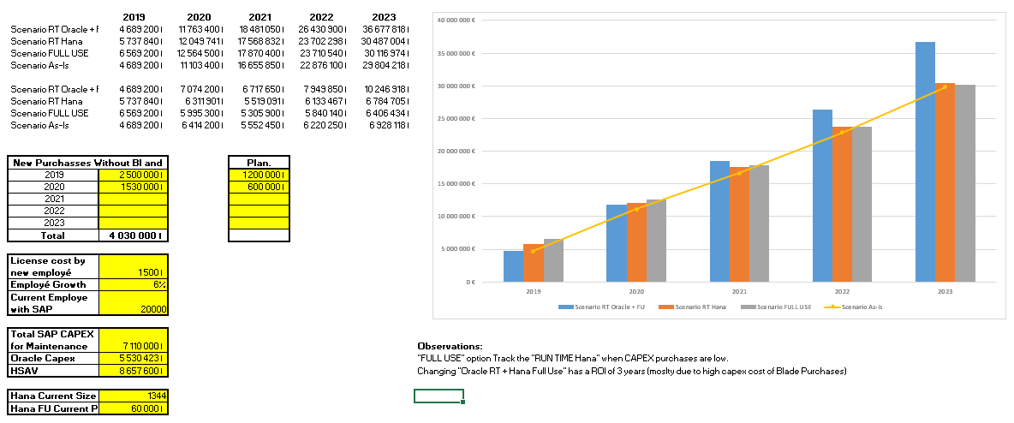
TOC studies are usually carried out for a 3-5 year forecast. This allows different options to be compared: Full Use, Run Time 8%, Run Time 15%, More Run Time, As-is etc.
In function :
- From SAP CAPEX
- The cost of Run Time, via Oracle or SAP HANA in 8% or 15%.
- Additional HANA Full Use capabilities to be acquired
- Maintenance flow linked to Run Time (Oracle or HANA) and the application
- Future purchases (users + applications)
- The cost of accommodation
The cumulative cost over a number of years allows us to identify whether a solution is clear in terms of TCO and ROI. An investment that can be easily justified will bring functional gains and demonstrate ROI through a reduction in TCO in less than three years.
Conclusion
To conclude this reflection and these non-exhaustive optimisation paths, you have been able to appreciate, if this was not already the case, that this subject is particularly complicated and generates very important financial and functional impacts. Bilink can help you:
- to study what the ideal application landscape would be for your needs,
- define the TCO of your solution, and
- help you in the argumentation to convince your management that these changes are necessary and provide a satisfactory ROI.
Jérôme Blanc
Latest articles by Jérôme Blanc (view all)
- SAP HANA Native Storage Extension (NSE) Q&A : Questions and Answers - February 6, 2020
- How to optimise your Data Platform investments? - 4 February 2020
- Stop saying 'BI Manager' and start saying 'Digital Data Manager' - 1 April 2019
